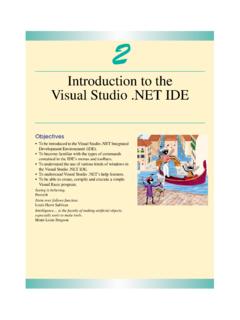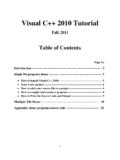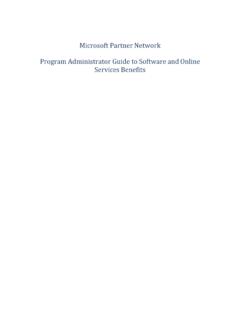Transcription of 120-2012: Developing Custom Metadata Reports …
1 1 Paper 120- 2012 Developing Custom Metadata Reports for SAS Data Integration studio Michael Kilhullen, SAS Institute Inc., Cary, NC ABSTRACT SAS Data Integration studio includes new functionality that allows you to run Reports through an interactive reporting facility. You can also create Custom Reports by using SAS Data Integration studio software's Java-based plug-in functionality. The plug-in can be written to generate report content using SAS code, Java code, or both. This is ideal for Developing Reports that specifically address the needs of data integration specialists such as documenting jobs or data standards defined in Metadata . This paper takes you through the steps necessary to add a basic Metadata report and discusses patterns for Developing Metadata report plug-ins. INTRODUCTION The purpose of the paper is to introduce you to a process for Developing Metadata Reports and adding them to the SAS Data Integration studio Reports interface (Figure 1).
2 I assume that you already know how to extract Metadata from the SAS Metadata Server. If not, the example used in this paper will give you a basic example but you need to spend some time learning this since it can become rather complex. Also, the method used in this paper focuses on PROC Metadata and will require the use of XML maps to transform the extracted Metadata to SAS data sets. Finally, the report will be created using standard SAS procedures and Output Delivery System (ODS). Figure 1 - Reports Tool Interface in SAS Data Integration studio The Reports tool is designed to easily integrate Metadata extraction and reporting through SAS. It provides the ability to change the report type by leveraging ODS. If you design your Reports with these constraints, you will be able to quickly add Reports to the Reports tool.
3 Although much more complex reporting solutions can be added (for example, the Job Documentation report that is shipped with SAS Data Integration studio ), this is beyond the scope of this paper. For the purpose of this paper, we will add a simple monitoring report that lists the SASL ibrary objects defined in a Metadata server and indicates which libraries are using the same directory path on a server. Developing Metadata Reports Extracting Metadata can be a complex process depending on Metadata that you need for your report . A best practice that I use to initially develop the Metadata report is to use Base SAS. This allows me to use the Metadata Browser window to explore Metadata , and more easily debug my Metadata requests, xml maps, and report code. For this paper, the Base SAS program is listed in Appendix 1: Metadata Extract and report Program in Base SAS.
4 To help you get started, I will cover some key concepts demonstrated in this code (Figure 2). Data ManagementSASG lobalForum2012 Developing Custom Metadata Reports for SAS Data Integration studio , continued 2 PROC Serverxml mapXML Libame engineSAS DatasetsReport Figure 2 - Anatomy of a Metadata report Program Using Base SAS SAS Metadata Reports rely on the use of PROC Metadata to extract the Metadata . The description of what Metadata needs to be extracted is specified in the file. When executed, the extracted Metadata is added to a file. We use an XML map to convert the Metadata to SAS data sets. Once we have a SAS data set, we can do anything else necessary to massage the data into a report format and produce the final report . DETERMINING WHAT Metadata TO EXTRACT For our report , we need to extract information about SASL ibrary objects including information about the directory name and server.
5 To understand how this is represented in Metadata , issue the METABROWSE command from your SAS session to open the Metadata Browser. The Metadata Browser allows you to view the Metadata server content in a hierarchical view. The Metadata Browser display for a SASL ibrary object is shown in Figure 3. Figure 3 Metadata Browser View of SASL ibrary Object If you examine the Metadata Browser window, you will see that a SASL ibrary object stores path information that is accessible through the UsingPackages association. EXTRACTING Metadata To extract Metadata , we will use PROC Metadata . PROC Metadata reads in an OMI-XML specification and outputs results to the Log window or external file. PROC Metadata allows the XML to be specified using a fileref, so we will adopt a pattern where the input and output are filerefs to code that we generate during execution.
6 This will allow us to modularize the code, make it easier to develop and debug in Base SAS, and facilitate reusability once we transition it into the Java environment. To extract the information that we identified earlier, we will use the following request: Data ManagementSASG lobalForum2012 Developing Custom Metadata Reports for SAS Data Integration studio , continued 3 <GetMetadataObjects> <ReposId>$METAREPOSITORY</ReposId> <Type>SASL ibrary</Type> <Objects/> <NS>SAS</NS> <Flags>260</Flags> <!-- OMI_GET_METADATA(256) + OMI_TEMPLATE(4) --> <Options> <Templates> <SASL ibrary ID="" Name="" Desc="" Engine="" isDBMS libname="" Libref="" MetadataCreated="" MetadataUpdated=""> <UsingPackages/> </SASL ibrary> <Directory ID="" DirectoryName="" IsRelative=""/> <DataBaseSchema ID="" Name="" Desc="" /> </Templates> </Options> </GetMetadataObjects> The <Templates> tag is used frequently in Metadata reporting.
7 It allows you to only extract the information needed for the report . For example, I specified that for Directory objects, I only want to see the DirectoryName and IsRelative attributes. READING EXTRACTED Metadata When PROC Metadata runs, it will write the extracted Metadata to an XML file. In order to access the content in SAS, XML maps are created. If you do not have experience creating XML maps, you can use the SAS XML Mapper to visually design the map, and then copy and paste the code it creates into your program. The XML map for the sample program creates a single table containing the information extracted from the Metadata server. The use of the SAS XML LIBNAME engine in the sample code is fairly typical so I will not discuss it specifically here. Refer to Appendix 1: Metadata Extract and report Program in Base SAS for an example of XML map code.
8 CREATING THE report Once the view model is created, you can use your favorite report method in Base SAS to produce the report . Since the example report has only a few columns, PROC PRINT will meet our needs. The final output in SAS is shown in Figure 4. Figure 4 - Metadata report Results in SAS CONVERTING THE PROGRAM TO A report PLUG-IN By using Base SAS to develop the Metadata report , most of the effort required to create a report plug-in is completed. The next step involves creating the necessary Java classes to plug this code into the SAS Data Integration studio Reports tool. This process is simplified by using a visual Java development tool such as Eclipse. Data ManagementSASG lobalForum2012 Developing Custom Metadata Reports for SAS Data Integration studio , continued 4 IMPLEMENTING REQUIRED METHODS An abstract implementation of the reporting interface has been provided called AbstractReport.
9 AbstractReport provides some default implementations of the interface methods. It assumes that the report is being generated with SAS ODS, and the ODS report Options dialog box is being used. Name and Description The name and description displayed for the report in the Reports tool (Figure 6) is taken from two methods as follows: public String getName() { return "Library report "; } public String getDescription() { return "Generate a report about libraries"; } Figure 6 - report Displayed in Reports Tool Category The report category is displayed in the Reports tool under the heading Type. The user can also choose to show Reports based on the category name. You can provide the name of an existing category or add a new one. This is especially useful when you are adding Reports targeting different user roles.
10 For the sample plug-in, we will create a new category called Samples (Figure 5). public String getCategory() { return "Samples"; } Source Code In the SAS Data Integration studio environment, the source code for the report must be submitted to the application server. A SASCodeGenerator class is provided in the Java environment that allows you to generate lines of code and/or comments, and to format the code when it is generated. For the most part, the code in the original program can be copied and pasted into the getSourceCode() method, and then each line needs to be enclosed in an addSourceCode() method. A very simple example of using the SASCodeGeneration class is as follows: SASCodeGeneration codeGen = new SASCodeGeneration(); ("A simple SAS program"); ("data;\n"); (2); ("x=1;\n"); ("y=2;\n"); (2); ("run;\n"); Figure 5 - Categories Selection Data ManagementSASG lobalForum2012 Developing Custom Metadata Reports for SAS Data Integration studio , continued 5 After your code is added, you can enhance it further using the SASCodeGenerator methods to generate very pretty and well-documented code.

















